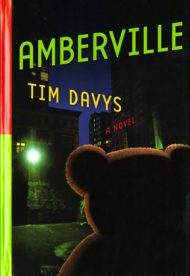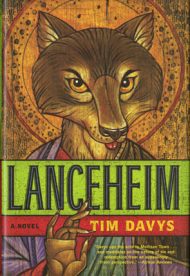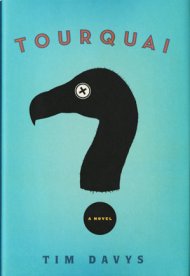Review: 'Amberville', 'Lanceheim', and 'Tourquai', by Tim Davys
The “Mollisan Town quartet”, by pseudonymous Swedish author Tim Davys, is (are?) four hard-boiled complex crime thrillers, each set in one of Mollisan Town’s four districts, with a stuffed-animal cast. Hey, if regular animals can be anthropomorphized, why not plushies?



“Amberville” (February 2009); hardcover $19.99 (343 pages), Kindle $8.99.
“Lanceheim: A Novel” (June 2010); hardcover $21.99 (371 pages), Kindle $9.99.
“Tourquai: A Novel” (February 2011); hardcover $19.99 (325 pages), Kindle $9.99.
The first three novels were published by Albert Bonnier Förlag in Stockholm in 2007, 2008, and 2010, and published in English by HarperCollins one or two years later; all three are translated by Paul Norlen. The concluding novel, Yok, is scheduled for July 2012.
The novels are themed to their districts:
The four districts of the city, distinct in their differences, competed at being the largest. In the past they had been independent villages, but they had grown together inexorably and had been forced to share resources. Amberville’s bourgeois prosperity; Tourquai’s hectic urban life; Lanceheim, which remained a city within the city; and, finally, Yok, which with each year in the present century had grown to be a greater and greater problem for the city’s administration. Today in each of the city’s districts there lived more than a million stuffed animals, of all types and colors, dispositions and mentalities. (Amberville, p. 22)
The colors can be garishly unrealistic; “Eric vaguely recalled one of the gorillas, the one who was bright red, from the distant past. It was a very unusual color for an ape.” (ibid., p. 6) Lanceheim has a vivid green Afghan hound with red eyes.
In Amberville, Eric Bear has put a life of crime behind him. He is now a megasuccessful advertising executive at the Wolle & Wolle agency, with a beautiful wife, Emma Rabbit, and a luxurious home in an exclusive apartment in one of Amberville’s registered historic townhouses. Then Eric’s old crime lord boss, Nicholas Dove, comes to him for help – or else! Dove believes that he is marked for the Death List, “the legendary roster of residents designated for pickup by the Chauffeurs, from whose red pickup truck no one returns.”:
Eric had heard the rumor of a Death List since preschool. As an adult it was hard for him to believe that a list actually existed. The Chauffeurs worked according to principles known only to them, and that of course gave rise to speculations. The Chauffeurs in their red pickup picked up old stuffed animals, ‘the worn and the weary,’ as the saying went. No one knew to where the old animals were conveyed, but they disappeared and were never seen again. It wasn’t strange that the Chauffeurs were feared, not strange that you wished there were some sort of list; anything at all that made the Chauffeurs’ nighttime runs seem less random. The Environmental Ministry was mentioned in this regard, because the Environmental Ministry was responsible for the city’s transports and for the so-called Cub List. But it was improbable that anyone at the ministry had the task of giving stuffed animals a death sentence. (p. 8)
Life and death as a plushie
To clarify the Mollisonian metaphysics here, everyone knows where stuffed animals come from: they are manufactured as cubs, applied for at the Environmental Ministry by animal couples who want to become parents, and brought to approved parents – who may be plushies of any species – by mysterious Deliverymen according to the mystical Cub List. The cubs are physically adult but mental blanks, and it is the parents’ job to teach them how to talk, the social graces, morality, etc.
There is also the equivalent of real-world mortality. Stuffed animals can count on getting picked up by the ominous Chauffeurs when they reach “old age”, but a random selection are chosen to “die before their time” to approximate fatal accidents, etc. Many animals believe that the victims are chosen based on an official Death List. Dove feels it is before his time, and he demands that Eric save him from the ominous Chauffeurs and their red pickup truck.
Whether the Death List exists or not, Dove has left instructions; if he should disappear, his gorilla thugs are to tear Emma apart and scatter her stuffing. Eric can’t take the chance that the Death List is a myth, so he reassembles his old gang of Sam Gazelle, Tom-Tom Crow, and Snake Marek to help him find out if the Death List is real and to get Dove taken off it; and in any case to find evidence that will convince Dove that he is not (or is “no longer”) on any such list. The four reassemble after ten years to investigate throughout Mollison Town for the semi-mythical List. The obvious tactic is to find a red pickup truck and trace it backwards; but of course it’s not that easy. As they slowly move from the slums to the heights of Mollison’s upper-class aristocracy, there are digressive chapters narrated by Eric’s “good” twin brother, Teddy Bear, who elaborates on the brothers’ past and secretly yearns after Eric’s wife, Emma Rabbit.
In the Teutonic Lanceheim district, famous composer Reuben Walrus is going deaf before he can complete his greatest symphony. He desperately hopes for a cure from the mysterious Forest faith-healer Maximilian, the notorious father-figure of a cult orchestrated through Wolf Diaz, Maximilian’s oldest friend and most loyal acolyte. (Mystically, Maximilian does not seem to have been “born” through normal cubhood, he alone grows larger through childhood, and nobody even recognizes what kind of animal he is.) But Maximilian has been declared a criminal fraud by the authorities, and he has gone into hiding. Walrus hires stereotypical private investigator Philip Mouse to find Maximilian before it is too late. Lanceheim expounds upon not only the messianic Maximilian, but also the stuffed animals’ established religion; Magnus who created the world, and Malitte, lord of evil. The first stuffed mythical animal is seen; a recording technician, Stripen Dragon.
In Tourquai, police superintendent Larry Bloodhound really wants to get the goods on suspicious wealthy financier Oswald Vulture. But when Vulture’s body is found headless in a “perfect crime”, Bloodhound attempts to bring justice to Vulture as he would to anyone else in Tourquai – especially since, as Vulture died an “unauthorized” death, he can be restored to life if his head can be found and reattached to his body. Bloodhound and his detective team of Anna Lynx and Falcon Ècu, with the help of p.i. Philip Mouse, investigate suspects who consider themselves to be above the law: Vulture’s sultry secretary, Emanuelle Cobra; his society wife, Irina Flamingo; his mistress, Jasmine Squirrel; Squirrel’s husband, art dealer/gambler Igor Panda; Panda’s art-forger underling, Jake Golden Retriever; …
Virtually all the reviews have described the three novels as conceptually imaginative but seriously flawed by a leaden pacing – more than one reviewer has called it “plodding” – and a “clunky” translation. True, but this is compensated for by some clever dialogue and unexpected plot twists in that leaden pacing:
Eric Bear […] was forty-eight years old. His wife was living under a death threat. But in his mama’s eyes a good night’s sleep and clean underwear were the most important things. Perhaps that was the way you should live your life? (Amberville, pgs. 62-63)
A more serious handicap is the traditional “crime noir” atmosphere where none of the characters are likeable. Sam Gazelle, one of the ‘good guys’ in Amberville, is an offensively swishy drug addict working in the porno industry. And I cannot imagine HarperCollins’ promotional video for Amberville as persuading anyone to buy the book.
The Telegraph (England) dismissed Amberville as “Watership Down with car chases” (despite a lack of car chases), which is a good simile for the following novels as well. The publisher’s blatantly coy references to the mysterious author’s hidden real identity (“his or her’s”) quickly grow irritating.
There are additional flaws from an anthropomorphic viewpoint. All of the same-sized characters act in the same all-too-human ways despite their animal-distinct names. They might as well all be plush humans. There are also occasional lapses in stuffed-animal reality:
Eric swallowed and nodded. Sweat was pouring down his back, but it might just as well have been the hangover. (Amberville, p. 7)
Stuffed animals that sweat? Really? Does that mean sweat glands in their stuffing? And what would sweat do to their stuffing?
The alley was not quite as narrow as the crow had thought, but the stench of urine was so overpowering that he almost turned around because of it. (ibid., pgs. 26-27)
Stuffed interiors apparently do not preclude normal bodily functions. In Lanceheim a stuffed giraffe has cancer of the throat. Regarding Snake Marek in Amberville, it is difficult to envision a snake without arms or legs becoming a prolific writer, musician (one is reminded of the utterly unconvincing snake harpists in Kathryn Lasky’s Ga’Hoole novels) and painter.
The three mysteries are distinctly intriguing, but when measured against what the reader can tell they should be, annoyingly disappointing. My recommendation is to try Amberville; then, if you like it despite its flaws, get the others.
All three attractively dissimilar covers are credited to Jarrod Taylor for their design; for compositing commercial photographs for Amberville, for the design and for choosing artist Marc Burckhardt for Lanceheim, and for himself for Tourquai. Amberville has a cover blurb by Eric Garcia, author of the anthropomorphized-dinosaur Dinosaur Mafia mysteries.
About the author
Fred Patten — read stories — contact (login required)a retired former librarian from North Hollywood, California, interested in general anthropomorphics
Comments
I've read the first two and will complete the third as soon as I get the chance. Really the big draw to this series, at least for me, is finding out the real story behind this world... which I sincerely hope the upcoming fourth book reveals. You find such small nuggets of what is really going in each book after so many pages of really very little - it can be a bit frustrating. Just as a sidenote, I read Lanceheim first (drawn of course to its cover) and then Amberville - at least with those two it did not really hurt reading them out of order.
They are slow-paced and a lot of the mechanics seem just completely unworkable (as you said, stuffed animals doing things or suffering illnesses which would be impossible). But, and this is why I preferred Lanceheim to Amberville, there are clues suggesting it is not really a real world as we would see it. I think there is sort of a shared illusion of reality in this world and that is a large explanation why things on the surface don't make a lot of sense, I don't want to give too much away in this review for those who haven't read the books (and certainly I have only read the first two) but I find my curiosity overcoming the shortcomings of these books and as I said... the author damn well better answer those questions in his upcoming and supposedly final fourth book ;)
Post new comment